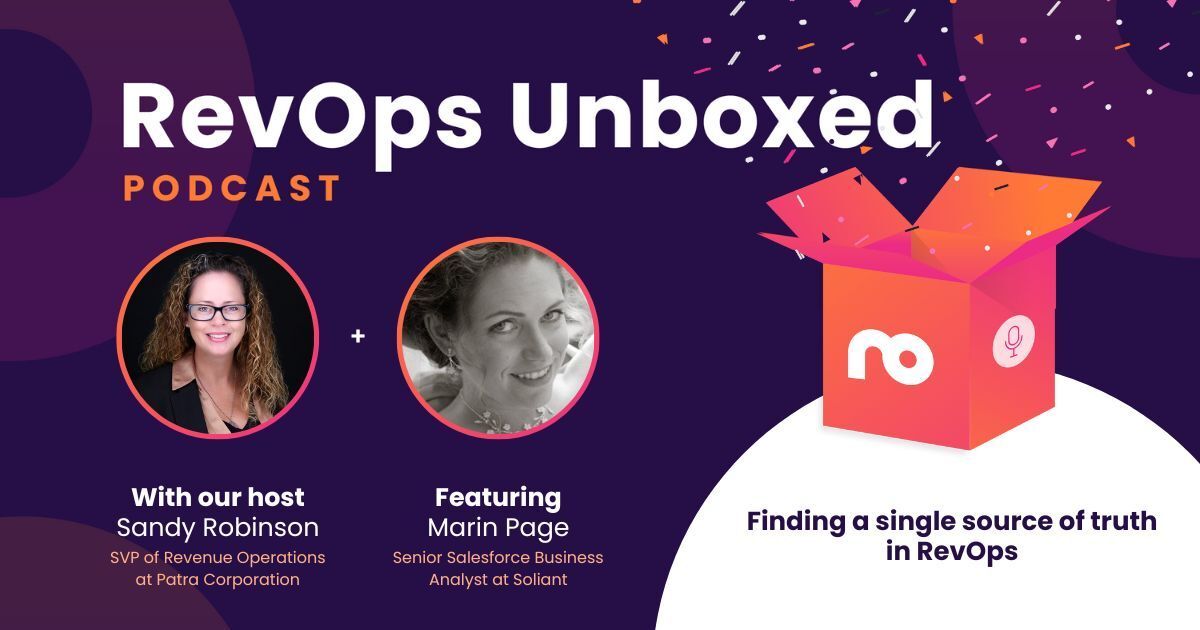This article comes from Joe Aurilia Jr.’s webinar, ‘How does Salesforce Integration fuel RevOps growth at different scale levels?’, for our community, check out the full discussion here.
With great flexibility comes great responsibility.
Salesforce enables immense revenue process customization. But without architectural planning, it becomes an inflexible tangle of integrations and automations. Changes generate ripple effects freezing operations in an instant.
But it doesn't have to be that way! In my 20+ years in ops leadership, I've learned how to transform revenue engines using Salesforce as the connective tissue.
When I first started with Salesforce, I'll admit - I was skeptical. It seemed overly complex for what we needed. But over time and through a lot of trial and error, Salesforce became the command center of our technology stack. It brought cohesion to our workflow and single-pane-of-glass visibility that I didn't think could be possible.

Whether you're just getting started or inheriting a complex Salesforce instance, my goal is to provide tactical advice to maximize your investment. With the right approach, Salesforce can scale with your most ambitious growth plans and unify your customer operations.
I'll share tips on smart setup, change management, customization, and integrating Salesforce deeply across your tech stack. You'll learn common pitfalls to avoid and keys to user adoption.
Let's get started on your journey to making Salesforce the beating heart of your revenue engine! With careful planning and continuous improvement, you can master the fundamentals and transform it into an indispensable system.
- Getting started with Salesforce
- Inheriting an existing Salesforce system
- Salesforce as an enterprise platform
- Final thoughts
Getting started with Salesforce
When first adopting Salesforce, it's crucial to view it as a journey rather than a single project. Salesforce offers tremendous flexibility - it's like buying a floor in a massive apartment building where all the utilities are provided, but it's up to you to make the space your own.
Salesforce offers common components like leads, accounts, and opportunities, but how you perceive and utilize these elements may vary greatly from other businesses.
This makes Salesforce an incredibly powerful and flexible platform, but to truly unlock its potential, you need to mold it to suit your unique business needs.
Salesforce is more than just a set of tools — it's a journey, a marathon that requires constant adjustments to reflect your business's evolution. But where do you start this journey? Here are a few points to consider:

Identifying key data
Initially, figure out what data matters most to your business. This could range from pre-sales conversations and coding processes to delivery and customer success metrics.
Once you identify this data, consider where it currently resides and how you can effectively import it into Salesforce, ensuring its quality and consistency.
Early wins and documentation
Small victories matter in this journey, both for business progress and team morale. It's crucial to document your revenue processes, ensuring that all teams, from sales and finance to marketing, understand and use the same terminology and definitions.
This uniformity paves the way for smoother conversations and better collaboration as your business matures and sets goals using KPIs and metrics.
Implementing controls
Salesforce offers an immense level of security and control, allowing you to tailor visibility and access levels according to team or region.
To leverage this feature efficiently, you need to plan early and understand Salesforce's control and security model thoroughly.
Remember, your CRM shouldn't be a free-for-all — maintaining data quality is essential for future reporting and decision-making based on the platform.
Thinking of Salesforce as an enterprise platform
Lastly, consider Salesforce as an enterprise platform and not just another tool. This will help you envision Salesforce as the cornerstone of your business operations, tying different elements together to provide more comprehensive, actionable insights.

Bonus advice
The journey with Salesforce is about growth and progress. It might take some time to derive intelligence from the platform, but the destination is undoubtedly worth it.
Lastly, understand where your business is heading—whether you're a budding startup or a mature company, your team size, ARR, and product complexity will significantly influence your Salesforce management strategy.
By appreciating the power and flexibility of Salesforce, you can effectively customize this robust platform to drive your business forward.
Your Salesforce journey is about making the platform truly yours, reflecting your unique needs and goals, and ultimately, unlocking your revenue potential.
Inheriting an existing Salesforce system
Taking over an existing Salesforce system might seem like a daunting task, but fear not!
First things first, you need to look at your system from a fresh perspective. It's like opening a book right in the middle – the story has already begun and you have to get up to speed with the plot.
🕰️ Understanding the past
How and why the system was initially set up - is vital in forging a clear path forward. By learning from past mistakes, you can avoid repeating them and continuously improve. Also, it's crucial to not just comprehend the system, but to be empathetic towards people who have been part of its journey.
🧍Now let's talk about people.
We all know they play a vital role in every organization. With RevOps, we have a golden opportunity to bridge gaps, dissolve conflicts, and bring teams closer.
🏅Internal communication
As you streamline your internal communication, it trickles down to improve your conversation with the most important entity - your customer. It's not always going to be easy, but celebrating the small victories along the way can create a positive and collaborative work culture.
🛣️ Business direction
You also need to ponder over a crucial question - Where are we heading? This is where you take a hard look at business goals. Can your existing system help you get there? Are there too many frictions or human handoffs holding you back?
📈Processes
You need to work out if your processes and systems are scalable, otherwise you risk getting bogged down in inefficiencies as the company grows.
🖥️Unique team dynamics
Another important thing to consider is your unique team dynamics and how they interact with the system. Are you a fast-paced startup, continually adapting, or a mature company with tried-and-true methods? Your company's stage will influence how you manage changes and make decisions about automation and processes.
🧮 Then there's the elephant in the room - data complexity.
Salesforce is a data-driven platform and understanding the amount and nature of your data will shape your decisions. Handling data in a startup can be significantly different from a mature company, so you’ll need to tailor your approach accordingly.
📣 Finally, let's not forget about communication!
No one likes nasty surprises, especially on a Monday morning. Informing your teams about upcoming changes, explaining the benefits, and setting clear expectations can smooth the path for successful transitions. After all, the goal here is to ensure that the changes are making everyone's life better, not harder.
Inheriting an existing Salesforce system might sound like a big challenge, but remember, it’s also a great opportunity. With a bit of empathy, clear communication, and an eye for future growth, you can navigate this journey with confidence. Let's embrace this challenge together, shall we?

Salesforce as an enterprise platform
In today's business environment, Salesforce is not just a tool for managing information or customers. It's an integral component of your company that enables smooth conversations and operations.
Imagine this: if Salesforce stopped working tomorrow, could your teams function effectively? This question underscores the true value of a fully integrated Salesforce platform – the heart of your enterprise where everything exists, and everything counts.
The power of data in Salesforce
A Salesforce platform fully adopted by all your teams is an efficient ecosystem with no secret spreadsheets or pipeline reports. It's a centralized hub, with all your integrations feeding in and out of the platform. These integrations enable smooth kickoffs of marketing conversations, notifications to stakeholders, and adhering to compliance procedures.
Understanding your data architecture and where data exists across your enterprise is crucial. Whether in Salesforce, HubSpot, or other financial and marketing tools, the ability to comprehend data flows is key, particularly as your organization matures. Data maps are beneficial in this context, helping teams to navigate through data, understand its origins, and identify who can modify it.

Facilitating repeatability and business intelligence
As you tweak your Salesforce system to enhance efficiency, you'll discover the power of repeatability – the ability to consistently deliver high-quality service without repeated mistakes. By streamlining processes and ensuring smooth handoffs, Salesforce can enable you to effect positive changes across all client interactions.
However, it's not just about managing processes; it's also about leveraging the data you've accumulated to derive actionable insights. Your Salesforce platform is a rich mine of business intelligence. By scrutinizing this data, you can uncover hidden trends, unexplored opportunities, and potential areas of improvement. It's about asking the right questions to drive significant, positive change.
Managing data control and customization
Salesforce is unique in its ability to adapt to various user profiles, presenting different "versions of the truth" based on the viewer's role. As you grow and understand your team's needs better, you can alter your Salesforce system to cater specifically to them. With data still managed in one place, you maintain control while providing a customized experience.
By aligning your systems and minimizing data entry duplication, you can create a "single pane of glass" view of your data. This unity aids in reporting, allowing for a cohesive narrative rather than disjointed snippets of information from different systems. Always striving to be "audit-friendly," this approach encourages buy-in and promotes continued system growth.

Tying business goals to Salesforce
With your data matured and trusted, you can confidently tie your OKRs and KPIs to your Salesforce system. As you become more familiar with the data's lifecycle, you can set goals based on quantifiable, trusted data. The ultimate aim? Driving business growth through specific, data-backed metrics because of the foundational elements you've put in place within your Salesforce system.
In essence, Salesforce as an enterprise platform is a crucial aspect of your business landscape. It facilitates smooth processes, insightful data analysis, and goal-oriented growth, putting you on the path to success.
Final thoughts
As we draw this insightful exploration to a close, it's clear to see that Salesforce integration, when approached strategically, has the potential to significantly elevate your business.
It's a platform that offers more than just CRM capabilities; it's a dynamic tool that can revolutionize your operations and unleash untapped revenue potential.
Whether you're a startup or a mature enterprise, Salesforce integration presents an opportunity to streamline processes, harness data, and drive growth at various scales.
Remember, Salesforce integration isn't a one-and-done project. It's a continuous journey that requires thought, persistence, and constant adjustment. With patience, strategic planning, and a willingness to learn, you can transform Salesforce from a simple tool into the heart of your revenue engine.
Now, it's over to you. What's your Salesforce story going to be?
For more valuable insights from industry leaders, join our global community! You won't want to miss it!





